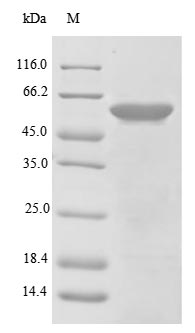Recombinant Mouse C-type lectin domain family 18 member A (Clec18a) is produced in E. coli and covers the complete protein sequence from amino acids 1-534. The protein comes with an N-terminal 6xHis-tag and shows greater than 85% purity when analyzed by SDS-PAGE. This reagent is designed for research purposes only and contains minimal endotoxin levels, which appears to make it appropriate for different laboratory studies.
Clec18a belongs to the C-type lectin domain family and seems to play an important role in recognizing carbohydrate structures. Proteins in this family are commonly found in immune response pathways, where they help mediate interactions between cells and pathogens. This makes Clec18a particularly interesting for researchers studying immune system functions and cell signaling. The protein may offer valuable insights into how cells communicate and defend against threats.
Potential Applications
Note: The applications listed below are based on what we know about this protein's biological functions, published research, and experience from experts in the field. However, we haven't fully tested all of these applications ourselves yet. We'd recommend running some preliminary tests first to make sure they work for your specific research goals.
Mouse Clec18a is a carbohydrate-binding protein that requires precise folding, proper disulfide bond formation, calcium ion coordination, and specific tertiary structure for its functional activity in immune recognition. The E. coli expression system cannot provide the eukaryotic folding environment or post-translational modifications that may be important for this lectin. While the full-length protein (1-534aa) contains all functional domains, the probability of correct folding with functional carbohydrate-binding activity requires experimental validation of disulfide bond formation and calcium-binding capability. The N-terminal 6xHis-tag may cause minimal steric interference but could potentially affect functional domains if not properly positioned.
1. Protein-Protein Interaction Studies Using Pull-Down Assays
This application carries a significant risk without proper folding validation. Clec18a interactions with carbohydrates or other proteins require precise tertiary structure and calcium-binding functionality. If correctly folded and active (verified through binding assays), the protein may identify physiological interaction partners. If misfolded/inactive (unverified), there is a high risk of non-specific binding or failure to replicate genuine interactions.
2. Antibody Development and Validation
This application is highly suitable as antibody development relies on antigenic sequence recognition rather than functional protein folding. The full-length protein provides comprehensive epitope coverage for generating Clec18a-specific antibodies. The high purity (>90%) ensures minimal contamination-related issues during immunization protocols.
3. Structural and Biochemical Characterization Studies
These studies are essential for determining folding status. Techniques should include circular dichroism spectroscopy to assess secondary structure, size-exclusion chromatography to evaluate oligomeric state, and calcium-binding assays to validate functionality. However, if misfolded/unverified, results will not reflect the native lectin structure.
4. Comparative Functional Studies Across Species
Meaningful comparative studies require native protein conformation and functional activity. If correctly folded and active (verified), the protein enables valid evolutionary comparisons of carbohydrate-binding properties. If misfolded/inactive (unverified), comparative analyses would yield misleading insights about lectin conservation and function.
Final Recommendation & Action Plan
The E. coli-expressed Clec18a with a small His-tag may not be properly folded for functional applications without experimental validation due to the lack of eukaryotic folding machinery. Begin with Application 3 (Structural Characterization) to assess folding quality through CD spectroscopy, SEC, and validate carbohydrate-binding activity using standard lectin assays (e.g., glycan array or ELISA-based binding). Applications 1 and 4 require rigorous functional validation before proceeding. Application 2 (antibody development) can proceed immediately. For reliable Clec18a research requiring native functionality, use mammalian expression systems that support proper disulfide bond formation and calcium binding, or implement refolding protocols with extensive activity validation.






